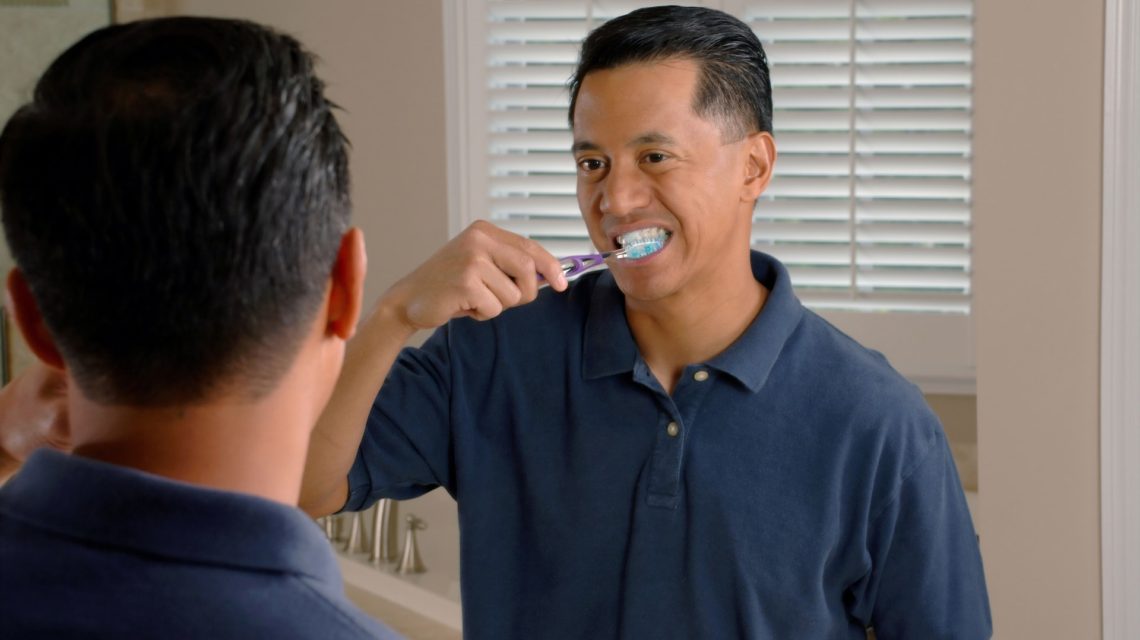Fixed dental bridges are one of the most common solutions for replacing a missing tooth. They are durable and will last a long time, but they do require a little maintenance. You will need to clean your bridge every day to prevent bacteria buildup and keep your mouth healthy.
But if you’ve never had a bridge before, keeping it clean takes practice. Here’s our guide on how to properly clean and floss underneath a dental bridge.
Why Do You Need to Clean Under a Dental Bridge?
A fixed bridge is a permanent appliance, and can’t be removed for cleaning like dentures. You also can’t floss between the false teeth of a bridge like you would with natural teeth. But that doesn’t mean you can skip flossing the bridge altogether.
Food can easily get caught under a dental bridge, because the false tooth has no root. If you don’t floss underneath it, bacteria will begin to accumulate in the gap between the false tooth and the gums.
Over time, the bacteria can cause gum inflammation and dangerous infections like gum disease. The bacteria can even spread to nearby teeth and cause cavities. To protect your mouth from tooth decay and gum disease, you must floss under your bridge every day.
How to Keep a Fixed Dental Bridge Clean
1: Brush Twice a Day
Brushing your teeth—dental bridge included—twice a day is crucial in eliminating plaque and bacteria. Without regular brushing, bacteria can weaken the teeth that support the bridge, causing the bridge to fail. Make sure to use a soft-bristled toothbrush and gentle pressure to avoid damaging the dental bridge or your tooth enamel.
2: Floss Under Your Bridge Daily
You also need to floss under your dental bridge every day to remove plaque and food particles. Simply slide the floss underneath the bridge, and gently move it back and forth. If you have a hard time getting string floss underneath the bridge, there are a few other tools you can try:
- A floss threader makes it easier to guide string floss underneath a bridge.
- Small, cone-shaped interdental brushes are designed to slide under the bridge and make cleaning the gums easier.
- A water flosser uses a stream of pulsing water instead of floss to clean underneath a dental bridge.
Interdental brushes and water flossers cannot replace the power of string floss when it comes to cleaning between your natural teeth. But on the other hand, they can help you get an even more thorough cleaning when combined with string floss.
3: Avoid Eating Hard and Sticky Foods
When you have a dental bridge, you need to be more careful about what you eat. Hard foods like nuts can damage a bridge, causing it to chip, crack, or pop out. And sticky foods like gummies and other candies can be difficult to remove if caught under the bridge, increasing your risk of gum disease and cavities.
4: Stop Bad Habits
Several kinds of bad habits can damage your dental bridge as well as your natural teeth, so it’s best to avoid or treat the following:
- Smoking
- Biting your nails
- Grinding or clenching your teeth
- Opening packages with your teeth
- Chewing ice or hard objects like pens
5: Visit Your Dentist Regularly
The best way to keep your bridge clean and your mouth healthy is to keep up with your regular dental appointments. Professional cleanings are much more thorough than what you can achieve with a toothbrush and floss at home. And the exam will help us spot any signs of wear or damage to your dental bridge so we can repair it.
Dental Bridges in Flagstaff, Arizona
If you want to replace a missing tooth with a dental bridge, or would like to schedule a cleaning, contact Country Club Dental. We provide durable, natural-looking fixed bridges, and are happy to answer any questions you may have about the procedure or how to clean a dental bridge.
Give us a call at 928-526-4314 to schedule an appointment with Dr. Paul Whitney or Dr. Mikaela Weedman.
Images used under creative commons license – commercial use (6/1/2023). Photo by National Cancer Institute on Unsplash


